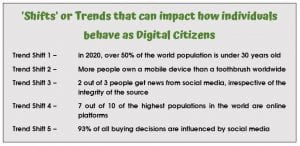The School Organisation Perspective
These changing social behaviours can directly impact on the need for, and development of, information policies in organisations in order to address these behaviours. It is not about the if the online world reaches students, more to the point it’s the how schools can prepare for managing their impacts and consider how to strategically expose students in a scaffolded and protected environment.
As stated in the Social media research ethical and privacy guidelines. Organisations and schools need to be particularly careful about the collection of data, how it is shared and published, with specific consideration for our young students.
For schools, sage journals published a journal article on the Qualitative Exploration of Electronic Image Sharing Among Young People which discusses and navigates the issues that adolescents face around Conformity, Trust, Intention and Reputation. Young people today are far more exposed to potential risks and exposure online including cyberbullying, image sharing and sexting, all problems that have not been issues prior to the social networking world.
The education for this begins for schools at a much earlier stage where children as young as 5 have exposure to digital platforms and social media. Some are even younger where platforms such as Facebook now have messenger for kids as an example. It is schools and adults that must keep our young people safe online.
Some considerations for schools:
- Organisations such as primary schools can minimise the level of negative impacts within their student community through providing education for parents and families.
- A current eSmart program for students to address trending digital social issues should be in place for students of all ages and relevant to their development and current online exposures.
- The student privacy and parent consent must be sought before sharing of any images or names on the internet. When schools do so, this must be completed considering the privacies and safety of the student.
- Appropriate policies should be in place to guide the school in order to keep all stakeholders safe online.
Some policies that I have devised for the primary school I work at include:
- ICT Acceptable Use Agreement
- Cyberbullying Policy
- Social Media Policy

These considerations help institutions ensure that risk mitigation is considered and in place. Despite the potential risk to students, it is important for a school to actively teach appropriate online etiquette and therefore equip our young people with the tools to successfully navigate their way through the ever changing online world that we now live in.
References
George Washington University Libraries. (2018). Social media research ethical and privacy guidelines. Retrieved from https://gwu-libraries.github.io/sfm-ui/resources/social_media_research_ethical_and_privacy_guidelines.pdf
Monks, H., Barnes, A., Cross, D., & McKee, H. (2019). A qualitative exploration of electronic image sharing among young people:Navigating the issues of conformity, trust, intention, and reputation. Health Education & Behavior, 46(2_suppl), 106S-113S. doi:10.1177/1090198119873921
The Digital Transformation https://youtu.be/6k_G_h41ZaQ

